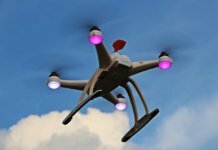As planned, the Federal Aviation Administration’s (FAA) recently established aviation rulemaking committee for small unmanned aircraft systems (UAS) flights operated over people has delivered its set of recommendations to the agency.
On Feb. 24, the FAA said it would not be pursuing a rule for micro UAS (under 4.4 lbs) in the final rulemaking for commercial UAS. Instead, it would seek a “flexible, performance-based regulatory framework that addresses potential hazards instead of a classification defined primarily by weight and speed.”
The agency then chose a rulemaking committee, which began its work in March and issued a report of recommendations on April 1 – similar to how November’s expedited drone registration task force operated.
The Associated Press reports that the committee recommended four different classifications of commercial UAS operated over people not involved in the operation:
1) Those weighing under 0.5 lbs would generally not be restricted, provided the manufacturers establish that there is a less than 1% chance a collision could cause serious injuries.
2) Small quadcopters (generally weighing between 4-5 lbs.) would need to be operated more than 20 feet above and 10 feet laterally from people. However, the specific design and operations would also play a role in the aircraft’s authorization to fly over crowds. In addition, manufacturers would need to establish that there is a less than 1% chance a collision could cause serious injuries.
3) Drones with up to a 30% chance of causing a serious injury from a collision would also need to be operated more than 20 feet above and 10 feet laterally from people but would not be permitted to operate over crowds of people or dense populations. Flights over any people would need to short, and these people would need to seek permission from the operator in order to be there.
4) UAS in the final category would also need to be operated more than 20 feet above and 10 feet laterally from people and show a 30% or less chance of serious injury from a collision, as determined by stringent safety testing. However, flights over crowds of people for a longer period of time would be permitted, provided that the drone operator has a “congested area plan.”
The FAA has said it plans to draft a rulemaking proposal after reviewing the aviation rulemaking committee’s report.
AirMap co-founder Gregory McNeal, who was one of the committee members, said in a release after the group was established, “Our industry is continuously evolving, and I applaud the FAA for taking an inclusive approach to the rulemaking process.”
The rulemaking committee was co-chaired by Earl Lawrence, director of the FAA’s UAS integration office, and Nancy Egan, general counsel for 3DR.













